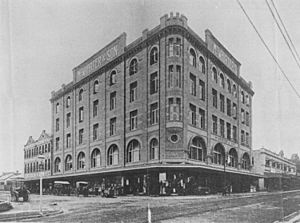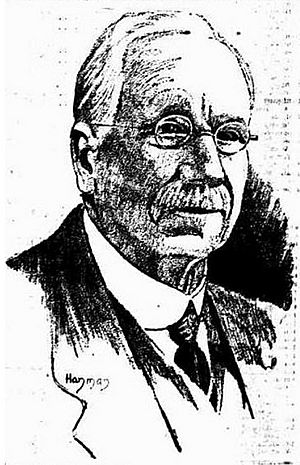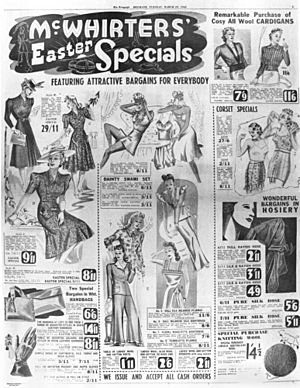McWhirters facts for kids
Quick facts for kids McWhirters Marketplace |
|
|---|---|
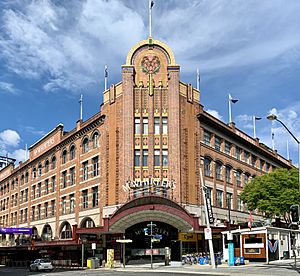
Wickham Street entrance, 2020
|
|
| Location | Wickham Street, Fortitude Valley, City of Brisbane, Queensland, Australia |
| Official name: McWhirters Marketplace, McWhirters, McWhirters & Son Ltd, Myer | |
| Type | state heritage (built) |
| Designated | 21 October 1992 |
| Reference no. | 600214 |
| Significant period | 1902–1931 (fabric) 1902–1955 (historical, McWirters) |
| Lua error in Module:Location_map at line 420: attempt to index field 'wikibase' (a nil value). | |
McWhirters is a famous old building in Fortitude Valley, Brisbane, Australia. It used to be a huge department store, which is like a very big shop with many different sections. Today, it's a modern shopping centre and has apartments too.
The building is listed on the Queensland Heritage Register. This means it's an important historical place that needs to be protected. It's also known as McWhirters Marketplace, McWhirters & Son Ltd, and Myer (Fortitude Valley).
Contents
The Story of McWhirters: A Big Shop's Journey
The McWhirters department store is made up of four brick buildings. They are between three and five storeys tall. These buildings were built in four different stages. This happened between 1899 and 1929. The land was bought by a draper (a fabric seller) named James McWhirter.
Starting a Business: James McWhirter's Dream
James McWhirter came to Australia in 1878 from Scotland. He worked for other businesses first. Around 1883, he started a fabric shop in South Brisbane. Later, he joined Thomas Charles Beirne in Fortitude Valley. In 1898, McWhirter bought another fabric business. This was the start of McWhirter and Son, drapers. It opened in September 1898 with 30 staff.
James McWhirter was a smart businessman. He started his shop when Queensland's economy was getting better. Even with a drought from 1900 to 1902, his business grew fast. In just 30 years, his small fabric shop became one of Brisbane's biggest department stores. It covered a huge area at the "Valley Corner."
Fortitude Valley: A Shopping Hotspot
In the early 1900s, Fortitude Valley became a very important shopping area in Brisbane. This was because it was easy to get there by train and tram. More people were also moving to nearby suburbs. Most importantly, there was strong competition between big shops like McWhirters, TC Beirne, and Overells. This attracted shoppers from all over Brisbane.
Growing Bigger: McWhirters Expands
From 1898, McWhirter & Son grew quickly. In 1899, McWhirter bought land at a busy corner. In 1902, they bought more land and made their shop bigger. By 1905, they built another warehouse. The company became McWhirter & Son Ltd.
By 1907, they had expanded into several nearby shops. In 1909, the company had 270 staff. They even had an office in London. They imported many items directly. They also had a large mail-order department. This sent goods to customers all over Queensland and beyond. They were the first to offer free shipping for mail orders.
Most of their customers were women. So, besides fabrics, they sold medicines, perfumes, silks, and home items. The front of the Brunswick Street building was changed by 1909. It had Brisbane's first "arcade front." Their colourful window displays were very popular.
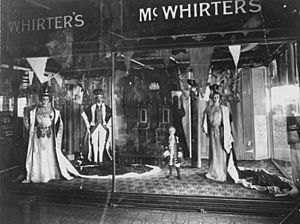
In 1910, McWhirter bought more land. He planned to build a very modern and well-equipped store. This would help with their growing business.
The Grand New Store of 1912
McWhirter hired Brisbane architects Atkinson and McLay. They designed a large, five-storey building. When it was finished in 1912, it became a famous landmark. People could see it from far away. It was called a "vast emporium" when it opened. The store was built with beautiful materials.
It was designed to be a very modern department store. It had new features for customer comfort. The ground floor had large display windows. There were five entrances. The main entrance had mosaic tiles and leadlights. Inside, it was well-ventilated and bright. The fittings were made of silky oak. The ceilings had pressed metal panels.
A sprinkler system was installed for fire safety. There were three electric elevators for customers. The pneumatic cash tube system was the biggest in Queensland. Hundreds of silky oak tables allowed customers to look at goods easily. This meant they did not always need a sales assistant.
The new store had over 50 departments. The ground floor had fabrics, jewellery, and travel goods. The first floor had hats and women's clothing. It had a special circular room for displays. This room had carpet, mirrors, and showcases. The second floor had furniture and carpets. The third floor had crockery, glassware, kitchenware, and toys. There was also a tearoom with views of the Brisbane River. The top floor had workrooms for making dresses and suits.
McWhirters clearly focused on female customers. The men's clothing department was in the older Brunswick Street store.
McWhirters and Modern Shopping
McWhirter's 1912 store was one of the first big department stores in Brisbane. It followed new trends in shopping. Between 1860 and 1920, people had more money and free time. Shopping became a popular activity for middle-class women. Early big stores like Bon Marche in Paris (1852) and Macy's in New York (1860) were models. In Australia, department stores grew from general stores.
These stores offered excellent service. The goal was to make customers feel special. This encouraged them to spend money. McWhirter and Son Ltd was a leader in this new shopping culture in Brisbane. They did well even during World War I.
Around 1918, a large, four-storey brick warehouse was built. One floor had a dining hall for staff. By 1921, McWhirter's also had a garage for their delivery vehicles.
Changes and Continued Growth
In 1919, James McWhirter (senior) went to Britain. His son, James (Jimmy) McWhirter junior, took charge. Sadly, Jimmy McWhirter passed away from illness in September 1919. James McWhirter (senior) returned to Brisbane in December 1919. In 1920, the company became a public company, McWhirters Ltd.
The company continued to grow. In 1921, they bought more land on Brunswick Street. McWhirter now owned almost all the land between Brunswick and Warner Streets, near Wickham Street. Building started again in 1922–1923. A new four-storey store was built. It had wide spaces, good lighting, and fast elevators.
James McWhirter died in England in 1925. But McWhirters Ltd kept growing. Fortitude Valley became a busy shopping area. McWhirters, TC Beirne, and Overells were the main stores. By the 1930s, McWhirters even made their own shirts. The mail-order department remained very important. They also offered credit and lay-by plans. McWhirters valued its employees. By 1931, some of the nearly 800 staff had worked there for over 30 years.
The Art Deco Corner: A New Landmark
In 1929, the company bought a lane next to their 1912 store. In 1930–31, McWhirters Ltd built a new brick building. This was during a tough economic time. This new building linked the 1912 and 1923 buildings. It was designed by architects TR Hall and LB Phillips.
The building had a special corner designed in the Art Deco style. This corner became a famous advertisement for the store. It was richly decorated with polychrome glazed terracotta tiles. The builder was George Alexander Stronach. Local firm Evans, Deakin, & Co. Ltd made the steel. Wunderlich supplied the tiles and pressed metal ceilings. McWhirters department store now had a huge floor space of 6.5 acres (about 2.6 hectares).
The outside of the 1930–1931 building looked like the older parts. But inside, it was very modern. There were no walls, so each floor was a huge open space. Large twin-elevators were installed. The pneumatic tube system was also made bigger. On the ground floor, there were three separate shops. These could stay open after the main store closed.
The Myer Era and Beyond
In 1955, the Myer Emporium took over McWhirters. They eventually renamed the store Myer. It operated until 1988. By then, its rivals, TC Beirne and Waltons, had closed. Myer then focused on its Queen Street store in the city centre. Fortitude Valley became less popular for shopping. This was partly due to more people using cars. Also, big suburban shopping centres like Westfield Chermside became popular.
In 1989, the building was redeveloped as McWhirters Marketplace. The inside was greatly updated. In 1997, apartments were added to the upper levels.
What McWhirters Looks Like Today
McWhirters is in the middle of Fortitude Valley. It's a large complex of brick buildings. They are three, four, and five storeys tall.
The building facing Warner Street (built around 1902-05) is three storeys. It has pale bricks and a decorative top section called a parapet. It has arched windows. Inside, it has an interesting timber roof structure.
The five-storey 1912 brick building is at the corner of Brunswick and Wickham Streets. Its outside walls have continuous vertical sections called piers. It has arched openings on the first and fourth floors. The parapet has a large cornice (a decorative molding). The corner of Wickham and Warner Streets is rounded. It has a castellated parapet (like a castle wall). Inside, this part still has some of its pressed metal ceilings.
The four-storey 1923 brick building faces Brunswick Street. Its outside looks similar to the 1912 building. It has a decorative brick section above the third-level windows. It also has a large parapet with the "McWhirters" name.
The 1930–1931 building faces Brunswick and Wickham Streets. It is four and five storeys tall. It matches the older buildings. The corner is very detailed with colourful glazed terracotta tiles. This corner has two brick piers that rise above the roofline. They have the "McW" monogram (logo) on them. The windows have tiled panels with diamond patterns. The main entrance is at this corner. It has a curved awning with decorative glass.
The entrance doors are set in black stone. The entrance foyer (lobby) is two storeys high. It is decorated with white marble panels and black marble patterns. Inside, this section has a steel structure covered in concrete.
A stepped metal awning goes around the whole building. Two sets of timber and etched glass doors are still in the 1912 section.
The outside of McWhirters still looks mostly the same. It is a very noticeable building. It helps show the early 1900s style of Fortitude Valley. Its unique corner is a landmark. Some parts of the old department store interiors can still be seen. This includes the roof structure of the 1902-05 building. Also, parts of the pressed metal ceilings and column decorations are in the 1912 building. The entrance hall of the 1930–1931 building also has beautiful decorations.
Why McWhirters is a Heritage-Listed Site
McWhirters Marketplace was added to the Queensland Heritage Register on 21 October 1992. This means it meets certain important standards.
- It shows how Queensland's history has changed.
The growth of McWhirters shows how Fortitude Valley became a major shopping centre. This continued for many years. It also shows how department stores developed in Queensland in the early 1900s.
- It has rare or special features.
The 1930–31 building has a beautifully detailed Art Deco corner. This is a rare and special part of Queensland's history.
- It shows what a department store should look like.
McWhirters is a great example of a large early 20th-century department store. It was built in stages. It used parts of its outside as advertising. It still has parts of its original decorations.
- It is beautiful and important to look at.
McWhirters is a very noticeable building. It adds a lot to the look of Fortitude Valley. The Art Deco corner is a famous Brisbane landmark. The entrance foyer has beautiful decorations.
- It is important to the community.
McWhirters at the Valley Corner has been a symbol of "The Valley" for many generations. It has a special meaning for people in Queensland.
- It is linked to important people or groups.
The place is strongly connected to James McWhirter and his company. It is also linked to the architects Atkinson & McLay and Hall & Phillips. McWhirters also shows the important work of the Wunderlich company.


